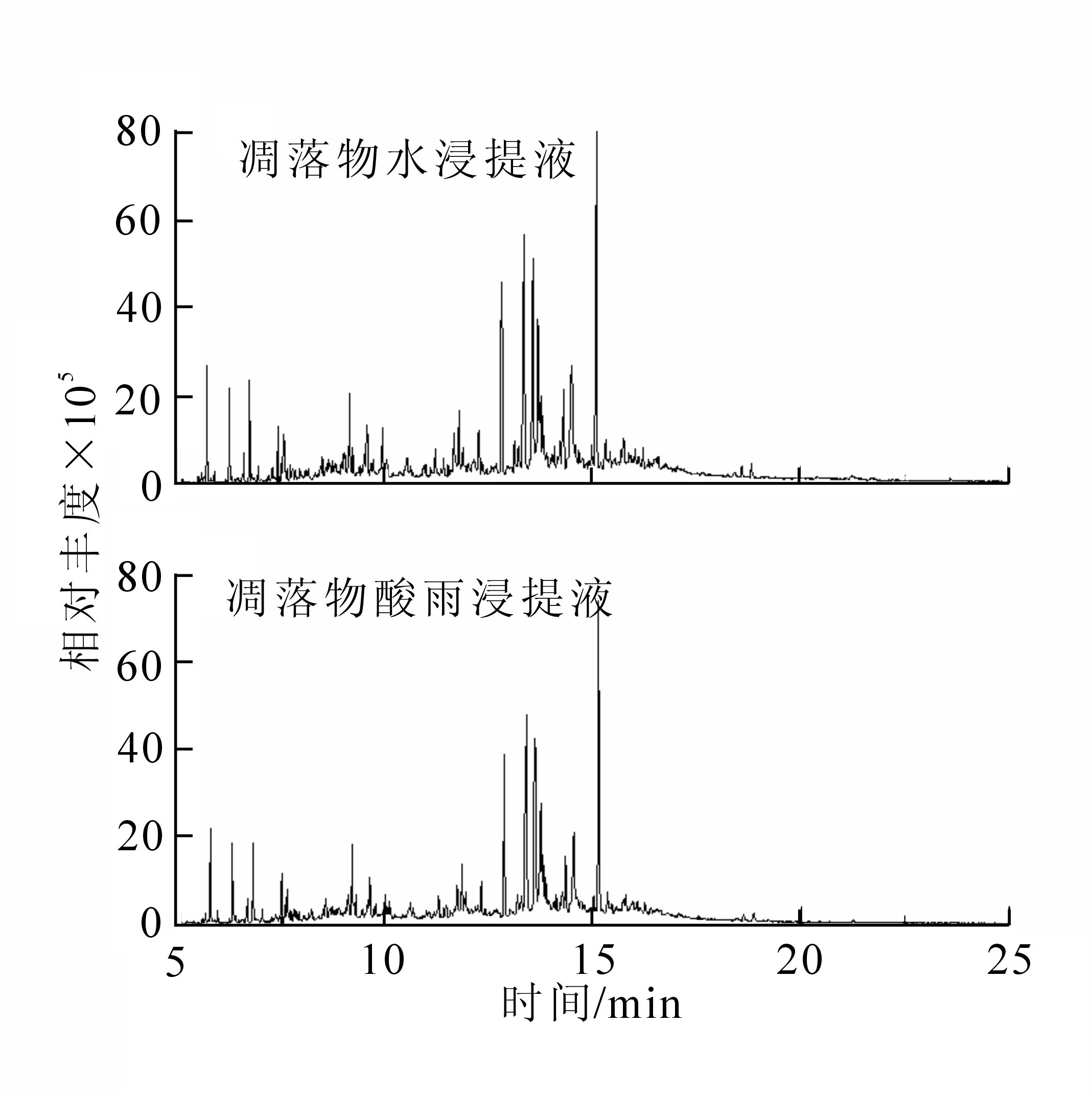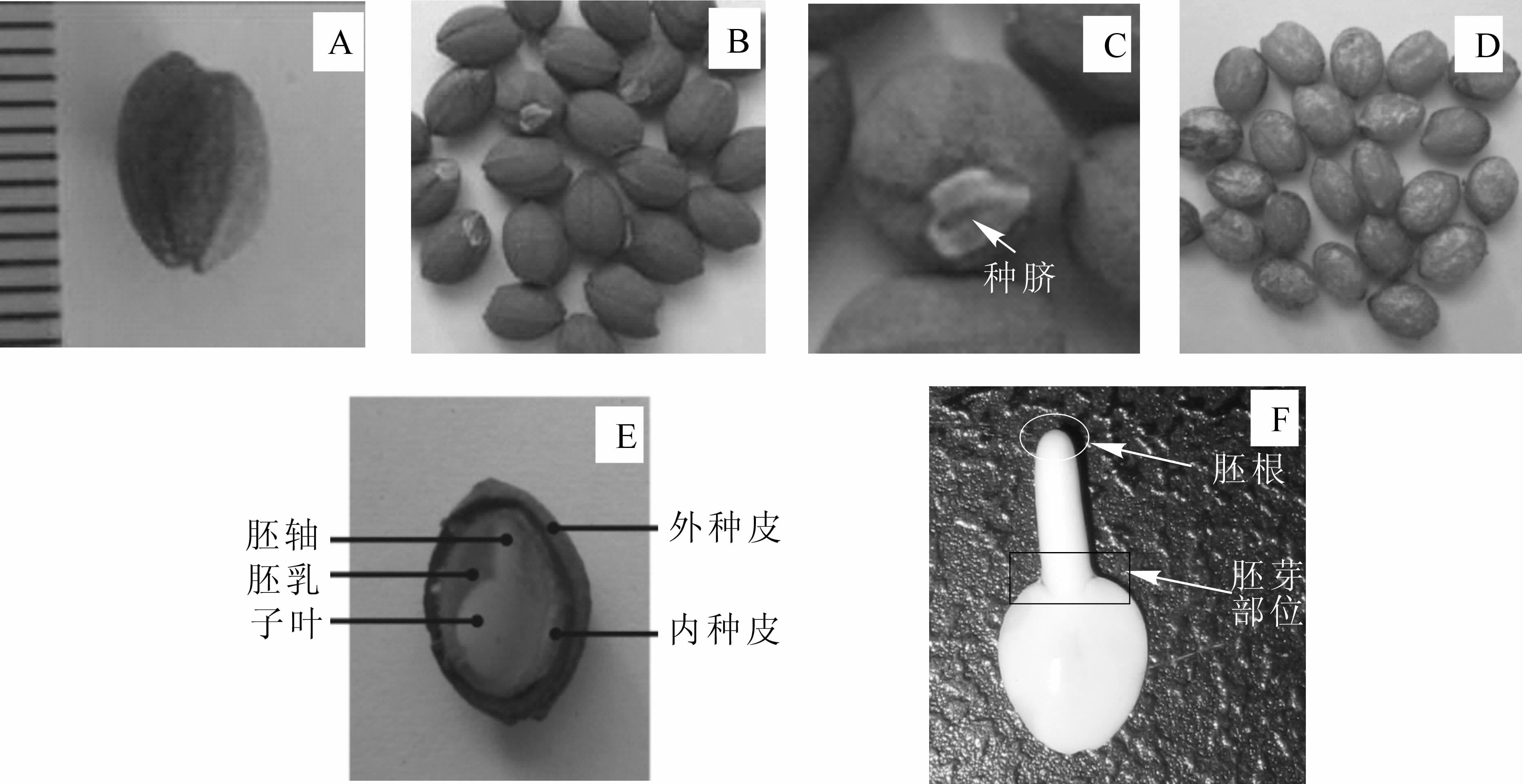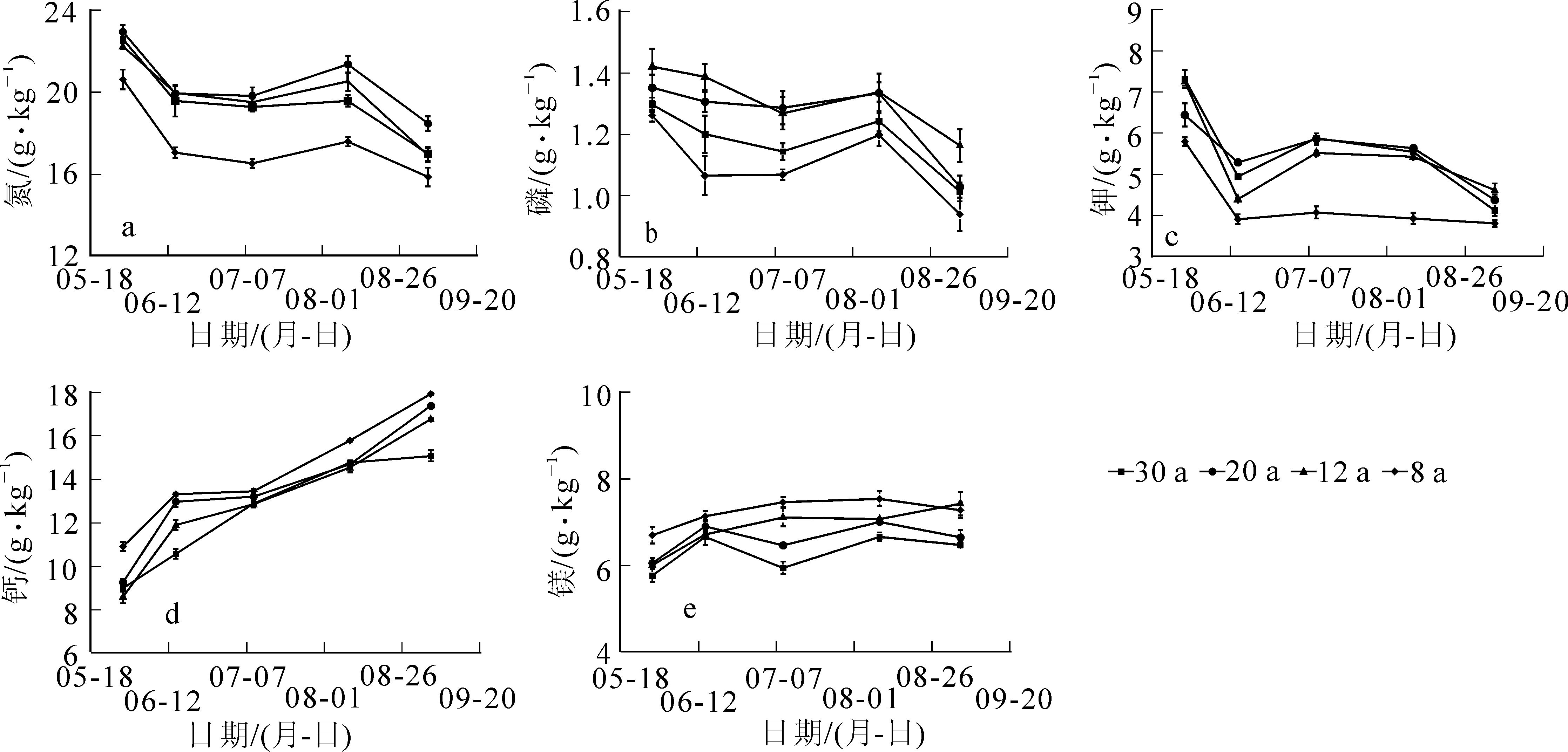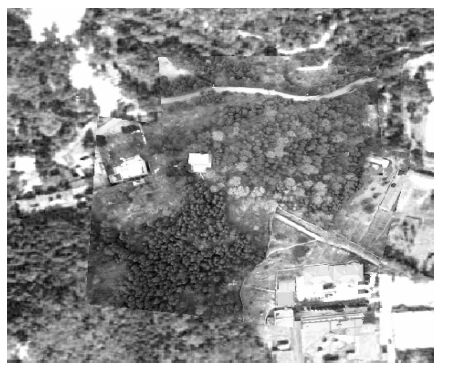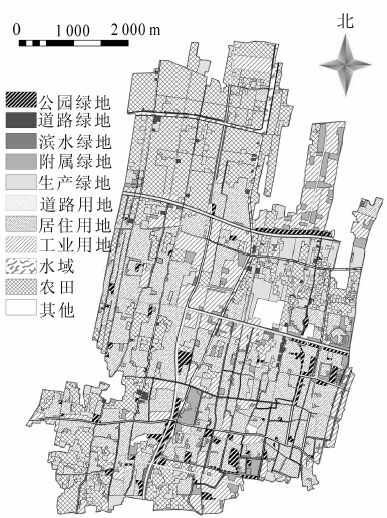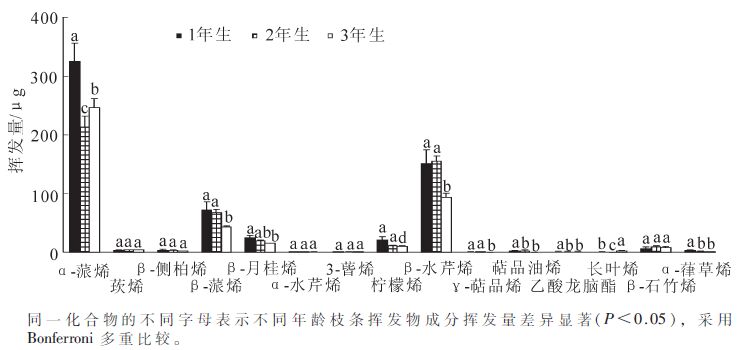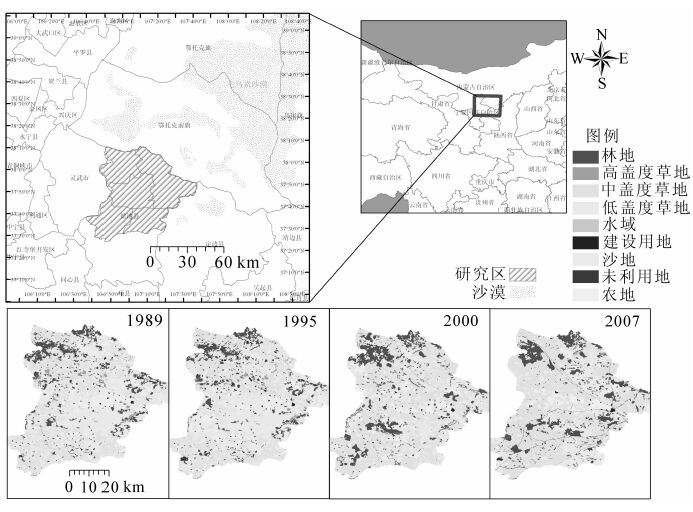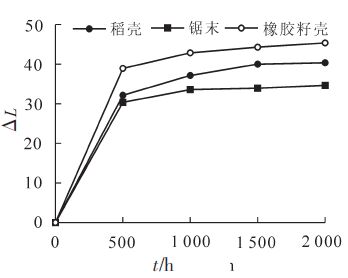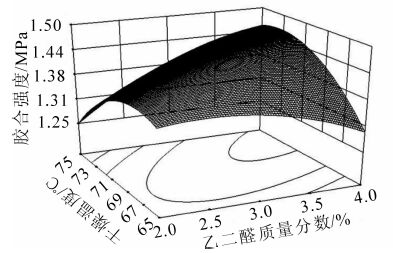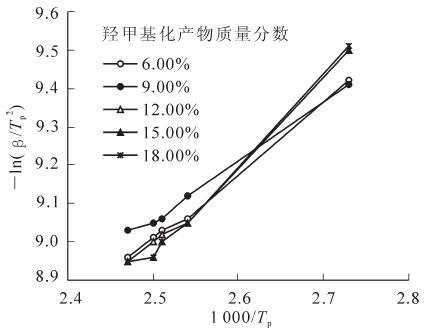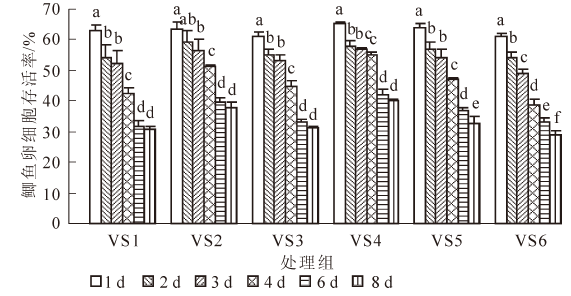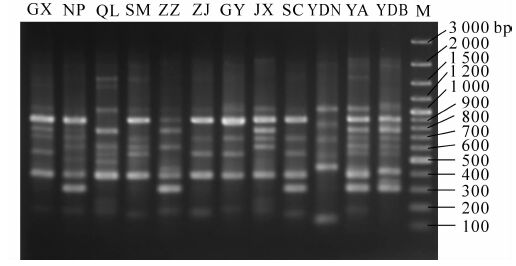2014 Vol. 31, No. 1
2014, 31(1): 1-8.
doi: 10.11833/j.issn.2095-0756.2014.01.001
Abstract:
In order to understand the combined effects of acid rain and litter on the growth of Cryptomeria fortunei,we studied the effects of the acid rain, aquatic extract and acid rain extracts from litter on the seed germination and seedling growth of C. fortunei by using petri dishes culture method,and analyzed the chemical components of the extracts using GC-MS. Results showed that:(1) Both simulated acid rain and aquatic extracts reduced the seed germination rate and germination potential of C. fortunei. Under the effects of acid rain extracts the seed germination rate and germination potential were significantly different from the controlled ones (P<0.05). It is indicated that acid rain enhanced the inhibition effect of allelochemicals from C. fortunei litter on its seed germination. (2) Acid rain declined the ratios of root to bud and root growth of C. fortunei. And acid rain(pH 3.0) significantly reduced the bud growth and biomass(P<0.05). At 50 g·L-1 the aquatic extracts significantly declined the root and bud growth,biomass and the ratios of root to bud(P<0.05). The growth indicators are significantly different from effects of acid rain extracts with the controlled ones(P<0.01). (3) 42 secondary metabolic compounds were identified in the aquatic litter extract of C. fortunei. The major compounds of the aquatic litter extracts and acid rain litter extracts were alcohols,phenolics,betweenanenes and esters, which all together accounted for 86.1% of the total. And in acid rain extracts,of which the newly released compounds including 4 ketones and two alcohols, accounted for 2.6% of the total.
In order to understand the combined effects of acid rain and litter on the growth of Cryptomeria fortunei,we studied the effects of the acid rain, aquatic extract and acid rain extracts from litter on the seed germination and seedling growth of C. fortunei by using petri dishes culture method,and analyzed the chemical components of the extracts using GC-MS. Results showed that:(1) Both simulated acid rain and aquatic extracts reduced the seed germination rate and germination potential of C. fortunei. Under the effects of acid rain extracts the seed germination rate and germination potential were significantly different from the controlled ones (P<0.05). It is indicated that acid rain enhanced the inhibition effect of allelochemicals from C. fortunei litter on its seed germination. (2) Acid rain declined the ratios of root to bud and root growth of C. fortunei. And acid rain(pH 3.0) significantly reduced the bud growth and biomass(P<0.05). At 50 g·L-1 the aquatic extracts significantly declined the root and bud growth,biomass and the ratios of root to bud(P<0.05). The growth indicators are significantly different from effects of acid rain extracts with the controlled ones(P<0.01). (3) 42 secondary metabolic compounds were identified in the aquatic litter extract of C. fortunei. The major compounds of the aquatic litter extracts and acid rain litter extracts were alcohols,phenolics,betweenanenes and esters, which all together accounted for 86.1% of the total. And in acid rain extracts,of which the newly released compounds including 4 ketones and two alcohols, accounted for 2.6% of the total.
2014, 31(1): 9-13.
doi: 10.11833/j.issn.2095-0756.2014.01.002
Abstract:
The seeds of Styrax tonkinensis have dormancy. Seed biological characteristics of Styrax tonkinensis including morphological structural features,1 000-grain weight,water absorption,viability,and the effect of seed germination with GA3,from Jishui of Jiangxi Province were studied in 2011 and 2012. Seed water absorption was tested with 3 pretreatment treatments of etching,shelling,and untreated. Seed viability testing methods utilized TTC staining. Seed germination test with 7 different treatments of GA3 from 250-1 500 mg·L-1. Results showed that the seed consisted of exopleura,endotesta,endosperm,radical,germ,hypocotyls,and cotyledons. In 2011 the average for seeds collected was:length-8.77 mm,width-7.91 mm,and 1 000-grain weight-136.70 g;and in 2012 the average was length-6.08 mm,width-5.20 mm,and 1 000-grain weight-95.68 g. The seed water absorption ability tested by 3 different treatments showd that seeds without exopleura had the best water absorption. The viability of seed tested by the TTC staining method showed,seed viability with TTC staining for seeds collected in 2011 was 97.78%. After being stored for one year,viability was still 94.44%. Seeds treated with GA3 showed improved seed germination and seedling growth with the best concentration being 1 500 mg·L-1.
The seeds of Styrax tonkinensis have dormancy. Seed biological characteristics of Styrax tonkinensis including morphological structural features,1 000-grain weight,water absorption,viability,and the effect of seed germination with GA3,from Jishui of Jiangxi Province were studied in 2011 and 2012. Seed water absorption was tested with 3 pretreatment treatments of etching,shelling,and untreated. Seed viability testing methods utilized TTC staining. Seed germination test with 7 different treatments of GA3 from 250-1 500 mg·L-1. Results showed that the seed consisted of exopleura,endotesta,endosperm,radical,germ,hypocotyls,and cotyledons. In 2011 the average for seeds collected was:length-8.77 mm,width-7.91 mm,and 1 000-grain weight-136.70 g;and in 2012 the average was length-6.08 mm,width-5.20 mm,and 1 000-grain weight-95.68 g. The seed water absorption ability tested by 3 different treatments showd that seeds without exopleura had the best water absorption. The viability of seed tested by the TTC staining method showed,seed viability with TTC staining for seeds collected in 2011 was 97.78%. After being stored for one year,viability was still 94.44%. Seeds treated with GA3 showed improved seed germination and seedling growth with the best concentration being 1 500 mg·L-1.
2014, 31(1): 14-18.
doi: 10.11833/j.issn.2095-0756.2014.01.003
Abstract:
The transcription factor of SEPALLATA3 (SEP3) belongs to the E class gene of the ABCE model of flower development. SEP3 has been shown to mediate complex formation and, therefore,a special attention was paid to its structure-function relationship. To determine how SEPALLATA3 protein oligomers were formed, the oligomeric status was studied by obtaining soluble protein expression in vitro. The SEP gene(AtSEP3) was constructed as a fusion protein and expressed in prokaryotic cells. After determining an optimal expression strategy, nickel chelating resin was used to purify the protein which was displayed as a tetramer in size exclusion chromatography(SEC). To get the high efficiency of soluble protein,different structural domains and expression conditions were screened,and 0.1% IPTG inducing at 22℃ for 15 h produced an optimal expression strategy. These preliminarily results provided an important basis for further study of the structure-function relationship. Overall,these results indicat that the SEP3 ‘glue’ protein in mediating multimerization is based on homomeric interactions.
The transcription factor of SEPALLATA3 (SEP3) belongs to the E class gene of the ABCE model of flower development. SEP3 has been shown to mediate complex formation and, therefore,a special attention was paid to its structure-function relationship. To determine how SEPALLATA3 protein oligomers were formed, the oligomeric status was studied by obtaining soluble protein expression in vitro. The SEP gene(AtSEP3) was constructed as a fusion protein and expressed in prokaryotic cells. After determining an optimal expression strategy, nickel chelating resin was used to purify the protein which was displayed as a tetramer in size exclusion chromatography(SEC). To get the high efficiency of soluble protein,different structural domains and expression conditions were screened,and 0.1% IPTG inducing at 22℃ for 15 h produced an optimal expression strategy. These preliminarily results provided an important basis for further study of the structure-function relationship. Overall,these results indicat that the SEP3 ‘glue’ protein in mediating multimerization is based on homomeric interactions.
2014, 31(1): 19-27.
doi: 10.11833/j.issn.2095-0756.2014.01.004
Abstract:
In order to understand the interaction of Trifolium repens with other garden plants,we studied the effects of the aquatic extract from leaves of T. repens on the growth,root activity,chlorophyll content,and antioxidant defense system in seedlings of Salvia splendens, Lobularia maritime, Dianthus chinensis, Festuca arundinacea and Dichondra repens using sand culture method,and analyzed the chemical components of the extract using GC-MS. Results showed that the aquatic extract from leaves of T. repens had significant allelopathic effects on seedling growth in S. splendens, L. maritime, D. chinensis, F. arundinacea and D. repens. The seedling growth index in S. splendens, L. maritime, D. chinensis, F. arundinacea and D. repens was highly significantly inhibited (P<0.05) by treatment with 50 g·L-1 of the aquatic extract;the root activity in the seedlings of the five garden plants were reduced by 24.0%,42.8%,51.6%,16.1% and 14.9%,respectively, and the chlorophyll content in these five garden plants were reduced by 13.6%,43.1%,30.5%, 57.1%,and 13.8%,respectively,compared with the control. At 5 g·mL-1,the extract significantly increased the activities of peroxidase(POD),superoxide dismutase (SOD) and catalase (CAT) in S. splendens, L. maritime, D. chinensis, F. arundinacea and D. repens; when aquatic extract from leaves of T. repens up to 50 g·L-1,it reduced the activities of those enzymes in five garden plants, while significantly increased the content of malondialdehyde(MDA) in the seedling of the garden plants. 42 compounds were identified in the aquatic extract from leaves of T. repens. The main compounds were 4-hydroxy-ionone(16.4%),isoamyl acetate(11.0%), dihydrocoumarone(9.6%),p-vinylguaiacol(7.4%),palustrol(6.4%),shyobunone(5.5%), maltol (4.9%),ionone epoxide(4.7%),and benzaldehyde,2-hydroxy-6-methyl-(4.2%),which all together accounted for 70.1% of the total.
In order to understand the interaction of Trifolium repens with other garden plants,we studied the effects of the aquatic extract from leaves of T. repens on the growth,root activity,chlorophyll content,and antioxidant defense system in seedlings of Salvia splendens, Lobularia maritime, Dianthus chinensis, Festuca arundinacea and Dichondra repens using sand culture method,and analyzed the chemical components of the extract using GC-MS. Results showed that the aquatic extract from leaves of T. repens had significant allelopathic effects on seedling growth in S. splendens, L. maritime, D. chinensis, F. arundinacea and D. repens. The seedling growth index in S. splendens, L. maritime, D. chinensis, F. arundinacea and D. repens was highly significantly inhibited (P<0.05) by treatment with 50 g·L-1 of the aquatic extract;the root activity in the seedlings of the five garden plants were reduced by 24.0%,42.8%,51.6%,16.1% and 14.9%,respectively, and the chlorophyll content in these five garden plants were reduced by 13.6%,43.1%,30.5%, 57.1%,and 13.8%,respectively,compared with the control. At 5 g·mL-1,the extract significantly increased the activities of peroxidase(POD),superoxide dismutase (SOD) and catalase (CAT) in S. splendens, L. maritime, D. chinensis, F. arundinacea and D. repens; when aquatic extract from leaves of T. repens up to 50 g·L-1,it reduced the activities of those enzymes in five garden plants, while significantly increased the content of malondialdehyde(MDA) in the seedling of the garden plants. 42 compounds were identified in the aquatic extract from leaves of T. repens. The main compounds were 4-hydroxy-ionone(16.4%),isoamyl acetate(11.0%), dihydrocoumarone(9.6%),p-vinylguaiacol(7.4%),palustrol(6.4%),shyobunone(5.5%), maltol (4.9%),ionone epoxide(4.7%),and benzaldehyde,2-hydroxy-6-methyl-(4.2%),which all together accounted for 70.1% of the total.
2014, 31(1): 28-36.
doi: 10.11833/j.issn.2095-0756.2014.01.005
Abstract:
The reflectance spectrum for photosynthetic pigments of Phyllostachys edulis,a widely distributed,important bamboo with high economic value in China,has a close relationship to the growth process of P. edulis leaves. To evaluate the relationship between reflectance spectra characteristics and pigment content,and to seek sensitive spectral parameters for exact estimations of damage in P. edulis leaves stressed by low temperature, pigment content and reflectance spectra indexes,such as spectral reflectance index wavelength of 705 nm(SR705),modified spectral ratio(mSR),pigment-specific simple ratio(PSSR), normalized difference vegetation index(NDVI),red NDVI(rNDVI),memory carotenoid reflectance index (Mcri),and photochemical reflectance index(PRI),in P. edulis leaves under low temperature stress were tested and a correlation analysis was used for comparison. Results showed that as temperature deceased, chlorophyll a content and carotenoids in the leaves significantly decreased(P<0.01). As the stress level increased,reflectance spectrum parameters(SR705,mSR,PSSR,NDVI,rNDVI,Mcri,and PRI)significantly decreased(P<0.01). The red-edge area(Sred)decreased,and the red-edge inflection(λred)position moved toward the short-wave direction with increasing stress. Significant correlations(P<0.05) were found for chlorophyll a content, carotenoids in the leaves and reflectance spectra characteristics, and first derivative of reflectance spectra at the wavelength regions for blue edge and red edge. Moreover, correlations were significant(P<0.01) between pigment content and spectral characteristic parameters of SR705(r=0.709),rNDVI(r=0.724),Mcri (r=0.706),and Sred(r=0.706). These reflectance spectrum parameters(PSSR,NDVI,rNDVI,and Sred)could be used to evaluate leaf pigment content.
The reflectance spectrum for photosynthetic pigments of Phyllostachys edulis,a widely distributed,important bamboo with high economic value in China,has a close relationship to the growth process of P. edulis leaves. To evaluate the relationship between reflectance spectra characteristics and pigment content,and to seek sensitive spectral parameters for exact estimations of damage in P. edulis leaves stressed by low temperature, pigment content and reflectance spectra indexes,such as spectral reflectance index wavelength of 705 nm(SR705),modified spectral ratio(mSR),pigment-specific simple ratio(PSSR), normalized difference vegetation index(NDVI),red NDVI(rNDVI),memory carotenoid reflectance index (Mcri),and photochemical reflectance index(PRI),in P. edulis leaves under low temperature stress were tested and a correlation analysis was used for comparison. Results showed that as temperature deceased, chlorophyll a content and carotenoids in the leaves significantly decreased(P<0.01). As the stress level increased,reflectance spectrum parameters(SR705,mSR,PSSR,NDVI,rNDVI,Mcri,and PRI)significantly decreased(P<0.01). The red-edge area(Sred)decreased,and the red-edge inflection(λred)position moved toward the short-wave direction with increasing stress. Significant correlations(P<0.05) were found for chlorophyll a content, carotenoids in the leaves and reflectance spectra characteristics, and first derivative of reflectance spectra at the wavelength regions for blue edge and red edge. Moreover, correlations were significant(P<0.01) between pigment content and spectral characteristic parameters of SR705(r=0.709),rNDVI(r=0.724),Mcri (r=0.706),and Sred(r=0.706). These reflectance spectrum parameters(PSSR,NDVI,rNDVI,and Sred)could be used to evaluate leaf pigment content.
2014, 31(1): 37-43.
doi: 10.11833/j.issn.2095-0756.2014.01.006
Abstract:
To provide reference for nutritional diagnoses and balanced fertilization, the seasonal changes and difference analysis of mineral nutrient contents in leaves during different phonological periods were analyzed, with Castanea mollissima ‘Zaofeng’ plantations at different ages(8 a,12 a,20 a,30 a)planted in Qianxi County of Hebei Province as experimental materials, aim to research the fertilizer demand regularity and nutritional differences of chestnut plantations at different ages. The results showed that(1)C. mollissima ‘Zaofeng’ plantations at different ages had the similar nutrition requirement regularity. Elements N,P,K,Ca,and B were in greater demand during pollination;N,P,K, and Ca demands were greater during the fruit expansion period;and Fe and Mn demand increased during fruit growth. However,Cu and Mg demand decreased in different phenological periods.(2)The difference analysis revealed lower Mg in the 20-and 30-year-old chestnut plantations than the 8-and 12-year-old plantations.(3)For 8-,12-,20-,and 30-year-old chestnut plantations,content of the main mineral nutrients in leaves changed the least from the middle of July to the middle of August. Since Mg decreased over time,the rate of Mg fertilizer application should be increased with time to keep chestnut trees at full productivity,and for optimal leaf nutrient analysis,sampling should be taken from the middle of July to the middle of August.
To provide reference for nutritional diagnoses and balanced fertilization, the seasonal changes and difference analysis of mineral nutrient contents in leaves during different phonological periods were analyzed, with Castanea mollissima ‘Zaofeng’ plantations at different ages(8 a,12 a,20 a,30 a)planted in Qianxi County of Hebei Province as experimental materials, aim to research the fertilizer demand regularity and nutritional differences of chestnut plantations at different ages. The results showed that(1)C. mollissima ‘Zaofeng’ plantations at different ages had the similar nutrition requirement regularity. Elements N,P,K,Ca,and B were in greater demand during pollination;N,P,K, and Ca demands were greater during the fruit expansion period;and Fe and Mn demand increased during fruit growth. However,Cu and Mg demand decreased in different phenological periods.(2)The difference analysis revealed lower Mg in the 20-and 30-year-old chestnut plantations than the 8-and 12-year-old plantations.(3)For 8-,12-,20-,and 30-year-old chestnut plantations,content of the main mineral nutrients in leaves changed the least from the middle of July to the middle of August. Since Mg decreased over time,the rate of Mg fertilizer application should be increased with time to keep chestnut trees at full productivity,and for optimal leaf nutrient analysis,sampling should be taken from the middle of July to the middle of August.
2014, 31(1): 44-49.
doi: 10.11833/j.issn.2095-0756.2014.01.007
Abstract:
Camellia spp. are widely used in many gardens and green areas of Shanghai. However, their growth patterns are different. To improve distribution and growth status of camellias in Shanghai,the physiochemical characteristics of planting soil and growth evaluation of selected species were studied by morphological and agrologic method. Results indicated that pH and electrical conductivity(EC)were important soil factors influencing growth. Soil pH in Jinhua was 6.66,but it was 7.77 for 8 selected soil samples in Shanghai. The soil EC for Camellia with the worst growth was 0.22 mS·cm-1, which was significantly higher than the soil for the better growing cultivar ‘Hongluzhen’ in Jinhua and Shanghai(P<0.05). In Shanghai, with the same cultivation procedures, different cultivars had different growth characteristics:‘Dahong Jinxin’,‘Zhuangyuan Hong’,and ‘Shiba Xueshi’ cultivars can tolerate light alkaline soils. In addition,a new cultivar ‘Xiao Fenyu’ grew well in alkaline soil with pH 8.16.
Camellia spp. are widely used in many gardens and green areas of Shanghai. However, their growth patterns are different. To improve distribution and growth status of camellias in Shanghai,the physiochemical characteristics of planting soil and growth evaluation of selected species were studied by morphological and agrologic method. Results indicated that pH and electrical conductivity(EC)were important soil factors influencing growth. Soil pH in Jinhua was 6.66,but it was 7.77 for 8 selected soil samples in Shanghai. The soil EC for Camellia with the worst growth was 0.22 mS·cm-1, which was significantly higher than the soil for the better growing cultivar ‘Hongluzhen’ in Jinhua and Shanghai(P<0.05). In Shanghai, with the same cultivation procedures, different cultivars had different growth characteristics:‘Dahong Jinxin’,‘Zhuangyuan Hong’,and ‘Shiba Xueshi’ cultivars can tolerate light alkaline soils. In addition,a new cultivar ‘Xiao Fenyu’ grew well in alkaline soil with pH 8.16.
2014, 31(1): 50-56.
doi: 10.11833/j.issn.2095-0756.2014.01.008
Abstract:
To determine characteristics and regularity in variation for population dynamics,a typical sample plot method was used for the Picea crassifolia population of Suyukou National Park located on the eastern slope of Helan Mountain. Then,based on all the data collected from 20 plots(10 m×10 m),population age structure was analyzed,population structure types were quantified, and static life table and time sequence models were drawn. Results of population age structure showed that the P. crassifolia population consisted mostly of small and medium-sized trees(82.4%),while seedlings,saplings,and mature trees were scarce; when future external interference from the time sequence model was taken into account, the population age structure dynamic quantitative index was V'pi=0.001 5>0,the survival curve leveled off at Deevey-Type Ⅱ,and the mortality rate peaked at 1 and 9 age-class. This indicated that the P. crassifolia population in Helan Mountain was in a transitory period between growth and steady-state forms;however,despite its self-renewal and resilience capabilities, with a small diameter class population and weak natural regeneration of saplings,a long protection period to facilitate afforestation is needed.
To determine characteristics and regularity in variation for population dynamics,a typical sample plot method was used for the Picea crassifolia population of Suyukou National Park located on the eastern slope of Helan Mountain. Then,based on all the data collected from 20 plots(10 m×10 m),population age structure was analyzed,population structure types were quantified, and static life table and time sequence models were drawn. Results of population age structure showed that the P. crassifolia population consisted mostly of small and medium-sized trees(82.4%),while seedlings,saplings,and mature trees were scarce; when future external interference from the time sequence model was taken into account, the population age structure dynamic quantitative index was V'pi=0.001 5>0,the survival curve leveled off at Deevey-Type Ⅱ,and the mortality rate peaked at 1 and 9 age-class. This indicated that the P. crassifolia population in Helan Mountain was in a transitory period between growth and steady-state forms;however,despite its self-renewal and resilience capabilities, with a small diameter class population and weak natural regeneration of saplings,a long protection period to facilitate afforestation is needed.
2014, 31(1): 57-63.
doi: 10.11833/j.issn.2095-0756.2014.01.009
Abstract:
High resolution remote sensing images of the study area were obtained with a digital camera bound to a model airplane. Then,images were corrected with forest characteristics and spatial attributes of Platycladus orientalis stands. Finally,a linear regression model was developed and tested based on field investigation,verification,and significance testing(P<0.05). Next,spatial structure of different forest stands in the survey region were analyzed using three classic spatial structure indexes:1)index-uniform angle index,2) neighborhood comparison,and 3)mingling. Results showed that growth in P. orientalis plantations was generally in a transition stage from unmixed to slightly mixed with a favorable distribution;however,the plantations were in a weak position in the completion. P. orientalis plantations that were slightly mixed and had good growth with a random distribution,varied in the completion.
High resolution remote sensing images of the study area were obtained with a digital camera bound to a model airplane. Then,images were corrected with forest characteristics and spatial attributes of Platycladus orientalis stands. Finally,a linear regression model was developed and tested based on field investigation,verification,and significance testing(P<0.05). Next,spatial structure of different forest stands in the survey region were analyzed using three classic spatial structure indexes:1)index-uniform angle index,2) neighborhood comparison,and 3)mingling. Results showed that growth in P. orientalis plantations was generally in a transition stage from unmixed to slightly mixed with a favorable distribution;however,the plantations were in a weak position in the completion. P. orientalis plantations that were slightly mixed and had good growth with a random distribution,varied in the completion.
2014, 31(1): 64-71.
doi: 10.11833/j.issn.2095-0756.2014.01.010
Abstract:
Taking Zonghan sub-district in Cixi City as a case study and applying GIS technology and landscape pattern index,this paper analyzed the characteristics of the landscape pattern in the study area. Based on the evaluation of landscape centrality index such as degree and closeness centrality,the research identified the town core green patches which were classified as three types,namely central,key and primary. Further,the ecological suitability analysis and the least-cost path model were utilized to establish the potential ecological corridors of the town green land system. Results showed that there were a total of 53 green patches which composed the core area of ecological network in town green land. A number of 14 potential ecological corridors were planned to connect the distribution of green land resources and the town core green patches in order to construct the town ecological green network system. The comprehensive methods supported by landscape pattern metrics,least-cost path model,and landscape centrality could be useful to evaluate the existing town green land system,optimize town ecological green network and supply the scientific basis for ecological network planning and management in town green land system.
Taking Zonghan sub-district in Cixi City as a case study and applying GIS technology and landscape pattern index,this paper analyzed the characteristics of the landscape pattern in the study area. Based on the evaluation of landscape centrality index such as degree and closeness centrality,the research identified the town core green patches which were classified as three types,namely central,key and primary. Further,the ecological suitability analysis and the least-cost path model were utilized to establish the potential ecological corridors of the town green land system. Results showed that there were a total of 53 green patches which composed the core area of ecological network in town green land. A number of 14 potential ecological corridors were planned to connect the distribution of green land resources and the town core green patches in order to construct the town ecological green network system. The comprehensive methods supported by landscape pattern metrics,least-cost path model,and landscape centrality could be useful to evaluate the existing town green land system,optimize town ecological green network and supply the scientific basis for ecological network planning and management in town green land system.
2014, 31(1): 72-77.
doi: 10.11833/j.issn.2095-0756.2014.01.011
Abstract:
Carbon flow of harvested wood products (HWP) plays a very important role to maintain the natural carbon balance between forest and atmosphere. To facilitate China's participation in the climate change negotiation,it is important to understand the carbon flows and the changes of HWP in the countries involved. Through the Intergovernmental Panel on Climate Change (IPCC) default approach,the stock change approach,the production approach, and the atmospheric flow approach,this paper analyzed the data on carbon emission and stock of HWP in eleven countries including China,and the influence of different conversion factors on carbon stock change. The results showed that carbon emission and stock of HWP in the United States, China, Brazil and Canada were higher than those in other countries. The wood products in China were a carbon pool. Different approaches would lead to different results. Both the stock change approach and production approach indicated that HWP in Japan was a carbon pool, however,the atmospheric flow approach indicated the opposite conclusion. Different conversion factors would affect the measure results of carbon stock change.
Carbon flow of harvested wood products (HWP) plays a very important role to maintain the natural carbon balance between forest and atmosphere. To facilitate China's participation in the climate change negotiation,it is important to understand the carbon flows and the changes of HWP in the countries involved. Through the Intergovernmental Panel on Climate Change (IPCC) default approach,the stock change approach,the production approach, and the atmospheric flow approach,this paper analyzed the data on carbon emission and stock of HWP in eleven countries including China,and the influence of different conversion factors on carbon stock change. The results showed that carbon emission and stock of HWP in the United States, China, Brazil and Canada were higher than those in other countries. The wood products in China were a carbon pool. Different approaches would lead to different results. Both the stock change approach and production approach indicated that HWP in Japan was a carbon pool, however,the atmospheric flow approach indicated the opposite conclusion. Different conversion factors would affect the measure results of carbon stock change.
2014, 31(1): 78-82.
doi: 10.11833/j.issn.2095-0756.2014.01.012
Abstract:
Feeding preferences,using laboratory feeding assays,of Monochamus alternatus adults on twigs of different ages,crown levels,and orientations for Pinus massoniana were studied by identifying and comparing their volatile profiles with a gas chromatography mass spectrometry (GC-MS) analysis. Results of the feeding assays of P. massoniana twigs demonstrated that M. alternatus fed preferentially on young tissue (one-> three-> two-year-old tissue). Similar feeding assays showed that adult M. alternatus fed preferentially on twigs at different crown levels (mid level> upper level> lower level) and orientation (south>north)of the tree. The GC-MS analysis showed that α-pinene content for different twigs of P. massoniana were different:one-> three-> two-year-old tissue, upper> middle> lower,and α-pinene content at the sides of the host crown being:south> north. The comparison showed that M. alternatus adults preferred twigs with high α-pinene content.
Feeding preferences,using laboratory feeding assays,of Monochamus alternatus adults on twigs of different ages,crown levels,and orientations for Pinus massoniana were studied by identifying and comparing their volatile profiles with a gas chromatography mass spectrometry (GC-MS) analysis. Results of the feeding assays of P. massoniana twigs demonstrated that M. alternatus fed preferentially on young tissue (one-> three-> two-year-old tissue). Similar feeding assays showed that adult M. alternatus fed preferentially on twigs at different crown levels (mid level> upper level> lower level) and orientation (south>north)of the tree. The GC-MS analysis showed that α-pinene content for different twigs of P. massoniana were different:one-> three-> two-year-old tissue, upper> middle> lower,and α-pinene content at the sides of the host crown being:south> north. The comparison showed that M. alternatus adults preferred twigs with high α-pinene content.
2014, 31(1): 111-116.
doi: 10.11833/j.issn.2095-0756.2014.01.017
Abstract:
Sandstorm is a serious threat to the local ecology,socio-economic development, and property in China's northern region. Clear perception of land use history and its main driving factors is crucial step to understand regional living environment,including its pattern, evolution and trends. The study was conducted in the northern sandy areas of Yanchi County,which was located on the southern edge of the Mu Us Sandyland. Spatial and temporal land use/land cover changes,such as land desertificationroad, residential land,and vegetation, were quantified from 1989-2007 using GIS and RS technology. The impact of these changes on the environment of human settlements was also analyzed. Results showed that:1)the most serious land desertification occurred around 1995,which accounted for 16.05% of the total area. Land desertification made the local living environment more difficult to improve. 2)road density doubled during study period, but there was a significant difference of road density in residential area varying from 2 to 6 km road buffer zones. 3) food security issues were highlightened because lots of farmland (around 49%)was developed into construction land. Overall population shifted towards northeast, but trend of green space,infrastructure construction are not well reflect this trend. Reasonable public land layout greatly influenced the process and achievements toward improving the living environment. 4)vegetation area showed a decreasing trend until 1995,followed by a significant increase; but "high coverage grassland" area continuous decreased. Vegetation change particularly changes in natural vegetation which was an important factor for a safe living environment should not be ignored. Our findings implied that there was a complex balance between land cover change and living environment. We strongly suggested the clear perception of spatial and temporal land use/land cover changes which would be helpful in guiding regional human settlement construction.
Sandstorm is a serious threat to the local ecology,socio-economic development, and property in China's northern region. Clear perception of land use history and its main driving factors is crucial step to understand regional living environment,including its pattern, evolution and trends. The study was conducted in the northern sandy areas of Yanchi County,which was located on the southern edge of the Mu Us Sandyland. Spatial and temporal land use/land cover changes,such as land desertificationroad, residential land,and vegetation, were quantified from 1989-2007 using GIS and RS technology. The impact of these changes on the environment of human settlements was also analyzed. Results showed that:1)the most serious land desertification occurred around 1995,which accounted for 16.05% of the total area. Land desertification made the local living environment more difficult to improve. 2)road density doubled during study period, but there was a significant difference of road density in residential area varying from 2 to 6 km road buffer zones. 3) food security issues were highlightened because lots of farmland (around 49%)was developed into construction land. Overall population shifted towards northeast, but trend of green space,infrastructure construction are not well reflect this trend. Reasonable public land layout greatly influenced the process and achievements toward improving the living environment. 4)vegetation area showed a decreasing trend until 1995,followed by a significant increase; but "high coverage grassland" area continuous decreased. Vegetation change particularly changes in natural vegetation which was an important factor for a safe living environment should not be ignored. Our findings implied that there was a complex balance between land cover change and living environment. We strongly suggested the clear perception of spatial and temporal land use/land cover changes which would be helpful in guiding regional human settlement construction.
2014, 31(1): 117-121.
doi: 10.11833/j.issn.2095-0756.2014.01.018
Abstract:
Aging properties of wood-plastic composites are directly related to their application. Currently,rubber wood and rubber seed shell are used in wood-plastic composites has not been reported. Changes on the surface of materials will be tested emphatically. Rice husk,rubber wood fiber,and rubber seed shell were each mixed with high-density polyethylene(HDPE) to make wood-plastic composites. Change in surface color, chemical composition, and degree of crystallinity for the three different materials subjected to ultraviolet(UV)weathering were monitored using color analysis, Fourier transform infrared spectroscopy(FTIR)and differential scanning calorimetry(DSC). Results showed that after 2 000 h of aging,the ΔL and ΔE for rubber wood fiber was 35 and 30,for husks was 40 and 37, and for rubber seed shell was 45 and 43,respectively. Also,the concentration of carbonyl groups on the surface of the three materials increased,and the degree of oxidation was enhanced. After aging 1 000 h,crystallinity of the rubber wood fiber treatment increased from 88.44 to 59.21(49.37%);for the husks treatment it increased from 94.00 to 63.53(47.96%); and for the rubber seed shell treatment it increased from 55.42 to 98.35(77.46%).
Aging properties of wood-plastic composites are directly related to their application. Currently,rubber wood and rubber seed shell are used in wood-plastic composites has not been reported. Changes on the surface of materials will be tested emphatically. Rice husk,rubber wood fiber,and rubber seed shell were each mixed with high-density polyethylene(HDPE) to make wood-plastic composites. Change in surface color, chemical composition, and degree of crystallinity for the three different materials subjected to ultraviolet(UV)weathering were monitored using color analysis, Fourier transform infrared spectroscopy(FTIR)and differential scanning calorimetry(DSC). Results showed that after 2 000 h of aging,the ΔL and ΔE for rubber wood fiber was 35 and 30,for husks was 40 and 37, and for rubber seed shell was 45 and 43,respectively. Also,the concentration of carbonyl groups on the surface of the three materials increased,and the degree of oxidation was enhanced. After aging 1 000 h,crystallinity of the rubber wood fiber treatment increased from 88.44 to 59.21(49.37%);for the husks treatment it increased from 94.00 to 63.53(47.96%); and for the rubber seed shell treatment it increased from 55.42 to 98.35(77.46%).
2014, 31(1): 122-128.
doi: 10.11833/j.issn.2095-0756.2014.01.019
Abstract:
To enhance the service life of plywood with preservative treatments,blends of borax,glyoxal,and glycerol were employed. Response surface methodology (RSM) was used to optimize preparation techniques for preserved plywood produced from poplar which had undergone soaking with preservative solution pretreatments bonded with phenol formaldehyde resin. To verify the predicted optimum point,six pieces of plywood were prepared using optimum manufacturing techniques. Results showed that the preservative solution should contain 6% borax (wt.),1% glycerol (wt.),and some glyoxal. The optimum manufacturing techniques were as follows:3.0% weight content of glyoxal in the preservative,70℃ drying temperature,and 5 h drying time. Resultant bonding strength of the response variables was 1.43 MPa, and the retention rate of boron was 50.63%. To verify the predicted optimum point, optimum manufacturing techniques of 1.46 MPa average bonding strength and 49.38% retention rate were used on 6 pieces of plywood resulting in no significant difference (P=0.01) from the predicted response variables. The test for interior antiseptic properties of preserved plywood prepared from the optimum manufacturing techniques showed a weight loss of 2.98%. Thus,the low weight loss met the high-level,antisepticised requirement for weight loss of less than 10%;thereby revealing the feasibility of these preservatives and manufacturing techniques for preserving plywood. The regression model for the manufacturing techniques of preserved poplar plywood was satisfactory and accurate and could be used to navigate the experimental design space.
To enhance the service life of plywood with preservative treatments,blends of borax,glyoxal,and glycerol were employed. Response surface methodology (RSM) was used to optimize preparation techniques for preserved plywood produced from poplar which had undergone soaking with preservative solution pretreatments bonded with phenol formaldehyde resin. To verify the predicted optimum point,six pieces of plywood were prepared using optimum manufacturing techniques. Results showed that the preservative solution should contain 6% borax (wt.),1% glycerol (wt.),and some glyoxal. The optimum manufacturing techniques were as follows:3.0% weight content of glyoxal in the preservative,70℃ drying temperature,and 5 h drying time. Resultant bonding strength of the response variables was 1.43 MPa, and the retention rate of boron was 50.63%. To verify the predicted optimum point, optimum manufacturing techniques of 1.46 MPa average bonding strength and 49.38% retention rate were used on 6 pieces of plywood resulting in no significant difference (P=0.01) from the predicted response variables. The test for interior antiseptic properties of preserved plywood prepared from the optimum manufacturing techniques showed a weight loss of 2.98%. Thus,the low weight loss met the high-level,antisepticised requirement for weight loss of less than 10%;thereby revealing the feasibility of these preservatives and manufacturing techniques for preserving plywood. The regression model for the manufacturing techniques of preserved poplar plywood was satisfactory and accurate and could be used to navigate the experimental design space.
2014, 31(1): 129-135.
doi: 10.11833/j.issn.2095-0756.2014.01.020
Abstract:
Phenol-formaldehyde (PF) resins were modified with starch and alkaline lignin and then plywood panels were manufactured with these modified PF resins. Differential scanning calorimetry (DSC) was used to determine the curing behavior of the modified phenolic resins,and a kinetic analysis was performed using the Kissinger and the Ozawa Methods. Influence of various factors on bond strength and formaldehyde emissions of the panels were determined. Results showed that,according to the National Standard, bond strength met the requirements for a Grade resin,and formaldehyde emissions of the manufactured panels met the requirements of Grade E1(1.5 mg·L-1). When the alkaline lignin content was 18.0% and addition of a hydroxymethylated product was 12.0%, bond strength reached a maximum of 1.22 MPa. When the alkaline lignin content was 18.0% and the addition of a hydroxymethylated product was 9.0%, formaldehyde emissions reached a minimum of 0.32 mg·L-1. Activation energies from the Kissinger Method were consistent with those calculated by the Ozawa Method. Compared to a lower hydroxymethylate content,resin with a higher hydroxymethylate content had a higher activation energy. Also,curing had nominal reaction orders between 0.69 and 0.86. Thus,with a higher hydroxymethylate content more energy was needed to activate the curing reactions of the resin,and the nominal reaction orders meant that the curing behavior of the modified phenolic resins was complicated.
Phenol-formaldehyde (PF) resins were modified with starch and alkaline lignin and then plywood panels were manufactured with these modified PF resins. Differential scanning calorimetry (DSC) was used to determine the curing behavior of the modified phenolic resins,and a kinetic analysis was performed using the Kissinger and the Ozawa Methods. Influence of various factors on bond strength and formaldehyde emissions of the panels were determined. Results showed that,according to the National Standard, bond strength met the requirements for a Grade resin,and formaldehyde emissions of the manufactured panels met the requirements of Grade E1(1.5 mg·L-1). When the alkaline lignin content was 18.0% and addition of a hydroxymethylated product was 12.0%, bond strength reached a maximum of 1.22 MPa. When the alkaline lignin content was 18.0% and the addition of a hydroxymethylated product was 9.0%, formaldehyde emissions reached a minimum of 0.32 mg·L-1. Activation energies from the Kissinger Method were consistent with those calculated by the Ozawa Method. Compared to a lower hydroxymethylate content,resin with a higher hydroxymethylate content had a higher activation energy. Also,curing had nominal reaction orders between 0.69 and 0.86. Thus,with a higher hydroxymethylate content more energy was needed to activate the curing reactions of the resin,and the nominal reaction orders meant that the curing behavior of the modified phenolic resins was complicated.
2014, 31(1): 83-88.
doi: 10.11833/j.issn.2095-0756.2014.01.013
Abstract:
The objectives were to analyze the effects of vitrification on the survival rate and succinate dehydrogenase(SDH) activity with immature oocytes in crucian carp(Carassius cuvieri). Results showed that the survival rate decreased significantly within 6 d after vitrification (P>0.05),and SDH activity continued to decrease(P<0.05). Glycol-based vitrification solutions(180.0 g·L-1 propylene glycol,110.0 g·L-1 methanol, 0.1 mol·L-1 trehalose and 40.0 g·L-1 polyethylene glycol) were selected for vitrification due to survival rates and SDH activity. This indicated that with this vitrification solution and method,cryopreservation for immature oocytes of crucian carp was practical.
The objectives were to analyze the effects of vitrification on the survival rate and succinate dehydrogenase(SDH) activity with immature oocytes in crucian carp(Carassius cuvieri). Results showed that the survival rate decreased significantly within 6 d after vitrification (P>0.05),and SDH activity continued to decrease(P<0.05). Glycol-based vitrification solutions(180.0 g·L-1 propylene glycol,110.0 g·L-1 methanol, 0.1 mol·L-1 trehalose and 40.0 g·L-1 polyethylene glycol) were selected for vitrification due to survival rates and SDH activity. This indicated that with this vitrification solution and method,cryopreservation for immature oocytes of crucian carp was practical.
2014, 31(1): 89-96.
doi: 10.11833/j.issn.2095-0756.2014.01.014
Abstract:
Syrmaticus ellioti (elliot's pheasant),is endemic to China and regarded as "Vulnerable" in the 2004 IUCN Red List of Threatened Species. Its population size believed to be declining because of ongoing habitat loss and hunting. From November 2009 to February 2010,direct observation and plot sampling in the field were utilized to survey the winter habitat selection of elliot's pheasant in Guanshan National Nature Reserve of Jiangxi Province. We collected 14 ecological factors from 34 sites used of elliot's pheasants in 6 transects throughout the study area. Cluster analysis and principal component analysis were employed to analyze the data. Results showed that S. ellioti preferred environmental factors of low elevation(≤600 m),shallow slope(≤30°),medium tree coverage(40%-70%),high shrub quantity (>20 trees),greater shrub diversity (>3 species),medium herbage coverage (20%-60%),greater herbage diversity (>3 species),greater herbage quantity (> 10 herbs),and close proximity to water (≤150 m). Sunny slopes and broadleaf forests were their favorite. Habitats with herbage cover of ≤20% and far from water(>150 m) were not suitable. S. ellioti avoided were steep(>30°) or shady slopes. A rotated matrix of the eigenvectors for S. ellioti habitat selection in winter revealed all 14 ecological factors grouped into three main factors and eight secondary factors. The main factors included herbage species,herbage quantity,and elevation;the secondary factors were herbage coverage, distance to water,tree coverage,shrub coverage,shrub species diversity,vegetation type, slope degree,and slope orientation.
Syrmaticus ellioti (elliot's pheasant),is endemic to China and regarded as "Vulnerable" in the 2004 IUCN Red List of Threatened Species. Its population size believed to be declining because of ongoing habitat loss and hunting. From November 2009 to February 2010,direct observation and plot sampling in the field were utilized to survey the winter habitat selection of elliot's pheasant in Guanshan National Nature Reserve of Jiangxi Province. We collected 14 ecological factors from 34 sites used of elliot's pheasants in 6 transects throughout the study area. Cluster analysis and principal component analysis were employed to analyze the data. Results showed that S. ellioti preferred environmental factors of low elevation(≤600 m),shallow slope(≤30°),medium tree coverage(40%-70%),high shrub quantity (>20 trees),greater shrub diversity (>3 species),medium herbage coverage (20%-60%),greater herbage diversity (>3 species),greater herbage quantity (> 10 herbs),and close proximity to water (≤150 m). Sunny slopes and broadleaf forests were their favorite. Habitats with herbage cover of ≤20% and far from water(>150 m) were not suitable. S. ellioti avoided were steep(>30°) or shady slopes. A rotated matrix of the eigenvectors for S. ellioti habitat selection in winter revealed all 14 ecological factors grouped into three main factors and eight secondary factors. The main factors included herbage species,herbage quantity,and elevation;the secondary factors were herbage coverage, distance to water,tree coverage,shrub coverage,shrub species diversity,vegetation type, slope degree,and slope orientation.
2014, 31(1): 97-104.
doi: 10.11833/j.issn.2095-0756.2014.01.015
Abstract:
Nature reserve and its neighborhood communities compose an organic whole. The attitudes of farmer households in the neighborhood towards the construction of nature reserve are important factors of its sustainable development. Based on a survey on the management status of 8 nature reserves and the livelihoods of 192 farmer households in 24 neighborhood communities in Zhejiang and Shaanxi Provinces,this paper analyzed the determinants of farmer households' attitudes towards the nature reserve development in the neighborhood through an Ologit model. The results indicated that if nature reserves could offer job opportunities and establish compensation systems for the communities,farmer households' willingness to support the nature reserve development would be improved. However the existing co-management by the reserves and local communities,and eco-tourism development had no significantly effects on farmer households' willingness to support. The farmer households with high consumption of firewood had lower support for the nature reserve development. The impacts of farmer households' incomes on their willingness to support were contradictory to the estimation and the impacts were limited. This paper suggested that to better develop nature reserves,a co-management mechanism by the reserves and local communities should be improved and its roles should be fully played. Government should establish a long-effect multiple compensation mechanism to improve the livelihoods of local farmers and reduce their direct reliance on the nature reserves.
Nature reserve and its neighborhood communities compose an organic whole. The attitudes of farmer households in the neighborhood towards the construction of nature reserve are important factors of its sustainable development. Based on a survey on the management status of 8 nature reserves and the livelihoods of 192 farmer households in 24 neighborhood communities in Zhejiang and Shaanxi Provinces,this paper analyzed the determinants of farmer households' attitudes towards the nature reserve development in the neighborhood through an Ologit model. The results indicated that if nature reserves could offer job opportunities and establish compensation systems for the communities,farmer households' willingness to support the nature reserve development would be improved. However the existing co-management by the reserves and local communities,and eco-tourism development had no significantly effects on farmer households' willingness to support. The farmer households with high consumption of firewood had lower support for the nature reserve development. The impacts of farmer households' incomes on their willingness to support were contradictory to the estimation and the impacts were limited. This paper suggested that to better develop nature reserves,a co-management mechanism by the reserves and local communities should be improved and its roles should be fully played. Government should establish a long-effect multiple compensation mechanism to improve the livelihoods of local farmers and reduce their direct reliance on the nature reserves.
2014, 31(1): 105-110.
doi: 10.11833/j.issn.2095-0756.2014.01.016
Abstract:
The objective of this work is to find a feasible approach for in situ remediation of main sources of river pollution. An isolated research area constructed of fishing nets, floating plants (Leersia hexandra,and Myriophyllum aquaticum),and biological belts coupled with artificial aeration was used for in situ remediation of sewage from rainwater pipes in the Shangzhuang River,Zhejiang Province. Water samples were collected every day and analyzed for water quality properties including dissolved oxygen (DO),chemical oxygen demand (COD),ammonium nitrogen (NH4+-N),total nitrogen (TN),and total phosphorus (TP) over a 100-day period. Results showed that when sewage concentrations were COD (100.20-178.80 mg·L-1), NH4+-N (10.50-17.89 mg·L-1),TN (12.15-21.47 mg·L-1),and TP (2.19-3.17 mg ·L-1),average after-treatment concentrations (in mg·L-1) for the main section dropped to DO of 5.50,COD of 34.3,and TP of 0.29,which were the fifth class for the national surface water quality standard;whereas NH4+-N was 3.41 mg·L-1 and TN was 4.43 mg·L-1. In the isolated research area,floating plants were directly responsible for N losses due to uptake of NH4+-N with the removal efficiencies of NH4+-N reaching 70.26% and TN being 71.41%. However,in the aerated field,N loss was mainly attributed to nitrification of bacteria,which accounted for 20.51% removal of NH4+-N and 5.74% removal of TN;uptake of floating plants and assimilation of bacteria removed TP with concentrations dropping to 0.29 mg·L-1 and removal efficiency reaching 88.1%. Thus,the isolated area constructed of fishing nets,floating plants,and biological belts coupled with artificial aeration could be an alternative for in situ remediation of main sources of river pollution.
The objective of this work is to find a feasible approach for in situ remediation of main sources of river pollution. An isolated research area constructed of fishing nets, floating plants (Leersia hexandra,and Myriophyllum aquaticum),and biological belts coupled with artificial aeration was used for in situ remediation of sewage from rainwater pipes in the Shangzhuang River,Zhejiang Province. Water samples were collected every day and analyzed for water quality properties including dissolved oxygen (DO),chemical oxygen demand (COD),ammonium nitrogen (NH4+-N),total nitrogen (TN),and total phosphorus (TP) over a 100-day period. Results showed that when sewage concentrations were COD (100.20-178.80 mg·L-1), NH4+-N (10.50-17.89 mg·L-1),TN (12.15-21.47 mg·L-1),and TP (2.19-3.17 mg ·L-1),average after-treatment concentrations (in mg·L-1) for the main section dropped to DO of 5.50,COD of 34.3,and TP of 0.29,which were the fifth class for the national surface water quality standard;whereas NH4+-N was 3.41 mg·L-1 and TN was 4.43 mg·L-1. In the isolated research area,floating plants were directly responsible for N losses due to uptake of NH4+-N with the removal efficiencies of NH4+-N reaching 70.26% and TN being 71.41%. However,in the aerated field,N loss was mainly attributed to nitrification of bacteria,which accounted for 20.51% removal of NH4+-N and 5.74% removal of TN;uptake of floating plants and assimilation of bacteria removed TP with concentrations dropping to 0.29 mg·L-1 and removal efficiency reaching 88.1%. Thus,the isolated area constructed of fishing nets,floating plants,and biological belts coupled with artificial aeration could be an alternative for in situ remediation of main sources of river pollution.
2014, 31(1): 136-144.
doi: 10.11833/j.issn.2095-0756.2014.01.021
Abstract:
Phytoremediation is an in situ potential strategy for cleanup of soil contaminated by heavy metals. Proper selection of plant materials is a key to successful phytoremediation in the field. A number of identified hyperaccumulators possess different physiological characteristics. Sedum alfredii plants typically have high heavy metal(e.g. Zn and Cd) accumulation capacity with fast growth rate as well. This paper reviewed the mechanisms of tolerance,absorption,transport and detoxification to heavy metals of this plant species, pointed out the existing problems in its research and finally made prospects of Sedum alfredii study,aiming to provide some references for better remediation of heavy metal contaminated soil in the future.
Phytoremediation is an in situ potential strategy for cleanup of soil contaminated by heavy metals. Proper selection of plant materials is a key to successful phytoremediation in the field. A number of identified hyperaccumulators possess different physiological characteristics. Sedum alfredii plants typically have high heavy metal(e.g. Zn and Cd) accumulation capacity with fast growth rate as well. This paper reviewed the mechanisms of tolerance,absorption,transport and detoxification to heavy metals of this plant species, pointed out the existing problems in its research and finally made prospects of Sedum alfredii study,aiming to provide some references for better remediation of heavy metal contaminated soil in the future.
2014, 31(1): 145-150.
doi: 10.11833/j.issn.2095-0756.2014.01.022
Abstract:
The research of wetland seeds bank is important to biodiversity conservation, restoration and management of wetland. There were many researches on wetland seeds bank and wetland restoration through seeds bank. However,there were also some problems. Based on the analysis of research on wetland seeds bank both at home and abroad,the authors argued that vegetative propagation existed extensively in wetland ecosystems and was the main reproductive way for many dominant species. Therefore, it is scientific to use seed banks concept in a general way when conducting wetland seeds bank research. In addition, disturbance,especially hydrological changes,had a great influence on wetland seeds bank. Species composition and seed germination patterns,which would affect plant communities,were significantly influenced by water level,intensity and frequency of flood. The research indicated that disturbances should be taken into consideration when restoring the wetland with seeds tank, otherwise it would be difficult to restore the community structure and biodiversity.
The research of wetland seeds bank is important to biodiversity conservation, restoration and management of wetland. There were many researches on wetland seeds bank and wetland restoration through seeds bank. However,there were also some problems. Based on the analysis of research on wetland seeds bank both at home and abroad,the authors argued that vegetative propagation existed extensively in wetland ecosystems and was the main reproductive way for many dominant species. Therefore, it is scientific to use seed banks concept in a general way when conducting wetland seeds bank research. In addition, disturbance,especially hydrological changes,had a great influence on wetland seeds bank. Species composition and seed germination patterns,which would affect plant communities,were significantly influenced by water level,intensity and frequency of flood. The research indicated that disturbances should be taken into consideration when restoring the wetland with seeds tank, otherwise it would be difficult to restore the community structure and biodiversity.
2014, 31(1): 151-155.
doi: 10.11833/j.issn.2095-0756.2014.01.023
Abstract:
To determine reference material for selective breeding of Sapindus mukorossi, genome DNA of 12 accessions, which were collected from different regions of India and China,were amplified with the sequence-related amplified polymorphism (SRAP) method using 18 primer pairs. Then,the cumulative band data generated from SRAP was used to calculate the Dice genetic similarity coefficient which was analyzed by the Unweighted Pair Group Method with Arithmetic Mean (UPGMA) to detect their mutual relationships. Genetic diversity was determined with a cluster analysis. Results showed that 191 of the total 253 generated bands were polymorphic (75.16%) with a mean coefficient of 0.739. The cluster analysis showed that the provenance in southern India had greater genetic diversity than other provenances. Compared to the provenance of southern India,less genetic diversity was noted for provenances of northern India and Chinese provenances where geographic latitudes were similar. Positive relationships occurred between genetic distance and geographic distance in 12 geographic provenances of S. mukorossi. Overall,the results showed a low level of diversity in this species.
To determine reference material for selective breeding of Sapindus mukorossi, genome DNA of 12 accessions, which were collected from different regions of India and China,were amplified with the sequence-related amplified polymorphism (SRAP) method using 18 primer pairs. Then,the cumulative band data generated from SRAP was used to calculate the Dice genetic similarity coefficient which was analyzed by the Unweighted Pair Group Method with Arithmetic Mean (UPGMA) to detect their mutual relationships. Genetic diversity was determined with a cluster analysis. Results showed that 191 of the total 253 generated bands were polymorphic (75.16%) with a mean coefficient of 0.739. The cluster analysis showed that the provenance in southern India had greater genetic diversity than other provenances. Compared to the provenance of southern India,less genetic diversity was noted for provenances of northern India and Chinese provenances where geographic latitudes were similar. Positive relationships occurred between genetic distance and geographic distance in 12 geographic provenances of S. mukorossi. Overall,the results showed a low level of diversity in this species.
2014, 31(1): 156-161.
doi: 10.11833/j.issn.2095-0756.2014.01.024
Abstract:
In order to sift out the optimum condition of proliferation and differentiation of rhizomes, using rhizomes from a filial generation of Cymbidium goeringii×C. hybridum,the effects of different basal medium[Murashige and Skoog (MS),1/2MS,Knudson C(KC),Vacin & Went(VW),B5],plant growth regulators[2,4-D,kinetin (KT),6-Benzylaminopurine (BA),and 1-Naphthalene acetic acid (NAA)]and organic additives (coconut milk,banana mud, and potato juice)on the proliferation and differentiation of rhizomes were compared. Results showed that 1/2MS was the optimal medium for proliferation of rhizomes. For differentiation of C. goeringii×C. hybridum ‘Wanderland’,2,4-D and KT had little effect;whereas 1/2MS supplemented with 1.0 mg·L-1 6-BA and 1.0 mg·L-1 NAA was the best combination for proliferation and differentiation. The organic additive coconut milk had the strongest influence on proliferation of rhizomes,followed by favorable proliferation and differentiation with 100 g·L-1 banana mud and 50 mL·L-1 potato juice.
In order to sift out the optimum condition of proliferation and differentiation of rhizomes, using rhizomes from a filial generation of Cymbidium goeringii×C. hybridum,the effects of different basal medium[Murashige and Skoog (MS),1/2MS,Knudson C(KC),Vacin & Went(VW),B5],plant growth regulators[2,4-D,kinetin (KT),6-Benzylaminopurine (BA),and 1-Naphthalene acetic acid (NAA)]and organic additives (coconut milk,banana mud, and potato juice)on the proliferation and differentiation of rhizomes were compared. Results showed that 1/2MS was the optimal medium for proliferation of rhizomes. For differentiation of C. goeringii×C. hybridum ‘Wanderland’,2,4-D and KT had little effect;whereas 1/2MS supplemented with 1.0 mg·L-1 6-BA and 1.0 mg·L-1 NAA was the best combination for proliferation and differentiation. The organic additive coconut milk had the strongest influence on proliferation of rhizomes,followed by favorable proliferation and differentiation with 100 g·L-1 banana mud and 50 mL·L-1 potato juice.
2014, 31(1): 162-166.
doi: 10.11833/j.issn.2095-0756.2014.01.025
Abstract:
For protection and exploitation of the medicinal plant Hemiboea subcapitata,a rapid propagation system was established through tissue culture for large-scale seedling. Murashige and Skoog (MS) media with different combinations of plant growth regulator[6-benzylaminopurine (6-BA),α-naphthalene acetic acid (NAA) and indole-3-butyric acid (IBA)] ratios was used to optimize the tissue culture of H. subcapitata, including callus induction, shoot proliferation, and rooting. Results showed that callus induction was difficult, but adventitious shoots could be differentiated directly from leaf explants subcultured in different combinations of growth regulators. The best medium for adventitious bud differentiation was MS + 0.5 mg·L-1 6-BA + 1.0 mg·L-1 NAA + 1.5 g·L-1 AC with the bud induction frequency of 67.78%, the average number for each leaf explant was 3.90 buds, and the highest was 6.69 buds. The best medium for subculture proliferation was MS + 0.5 mg·L-1 6-BA + 0.5 mg·L-1 NAA with a proliferation of 23.43 times. For all treatments and with different concentrations of IBA, the rooting ratio was more than 90%. This tissue culture technique and rapid propagation system of H. subcapitata could be used for large-scale seedling propagation in a short time and for technical guidance in large-scale production.
For protection and exploitation of the medicinal plant Hemiboea subcapitata,a rapid propagation system was established through tissue culture for large-scale seedling. Murashige and Skoog (MS) media with different combinations of plant growth regulator[6-benzylaminopurine (6-BA),α-naphthalene acetic acid (NAA) and indole-3-butyric acid (IBA)] ratios was used to optimize the tissue culture of H. subcapitata, including callus induction, shoot proliferation, and rooting. Results showed that callus induction was difficult, but adventitious shoots could be differentiated directly from leaf explants subcultured in different combinations of growth regulators. The best medium for adventitious bud differentiation was MS + 0.5 mg·L-1 6-BA + 1.0 mg·L-1 NAA + 1.5 g·L-1 AC with the bud induction frequency of 67.78%, the average number for each leaf explant was 3.90 buds, and the highest was 6.69 buds. The best medium for subculture proliferation was MS + 0.5 mg·L-1 6-BA + 0.5 mg·L-1 NAA with a proliferation of 23.43 times. For all treatments and with different concentrations of IBA, the rooting ratio was more than 90%. This tissue culture technique and rapid propagation system of H. subcapitata could be used for large-scale seedling propagation in a short time and for technical guidance in large-scale production.




